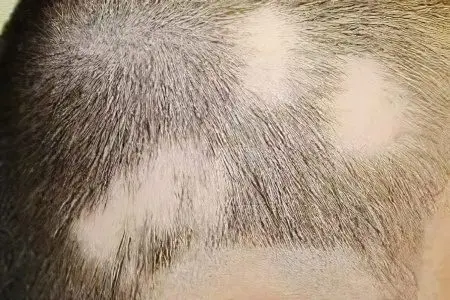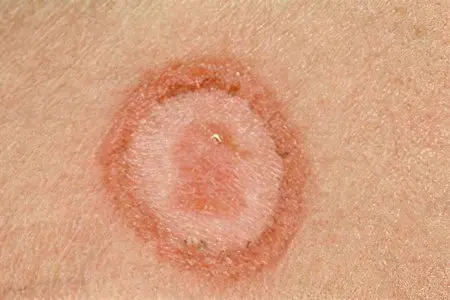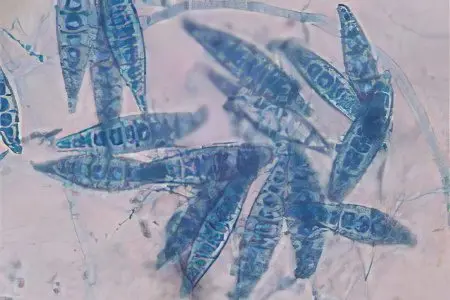Contents

Ringworm – a disease of the skin, nails and hair of a person, which is provoked by pathogenic fungi and is highly contagious. This type of fungal infection has been well studied in medicine, it can be called trichophytosis or microsporia, as it is caused by two types of mycotic organisms: Microsporum and Trichophyton. Other synonyms for ringworm are terms such as: dermatophytosis, dermatophytosis, ringworm.
Microsporia is a highly contagious infection, children are at an increased risk. Moreover, boys are five times more likely to be infected with ringworm than girls. It is customary to distinguish between microsporia of smooth skin and scalp. Nails are involved with the pathological process much less frequently.
Distinguish:
Zooanthroponotic microsporia, the causative agent of which affects dogs, cats and humans;
Anthroponous microsporia, the causative agent of which affects only humans;
Geophiles – pathogens of this type of microsporia live exclusively in the soil, infection can occur only through contact with it.
According to available statistics, microsporia affects from 50 to 70 people out of 100. The disease is seasonal in nature, it is more widespread in the warm season. In those regions where a hot climate prevails, the infection is diagnosed much more often.
Trichophytosis can be transmitted either from animals to humans, or from person to person. Only people suffer from anthroponous trichophytosis, most often they are children. Zooanthroponic trichophytosis can be transmitted from domestic animals, or from mice to humans.
ringworm symptoms
Symptoms of ringworm can vary somewhat, depending on the location of the infection, on disorders in the immune system and on its ability to cope with the disease.
In this regard, it is customary to distinguish:
Lichen superficial with localization on the scalp. Most often, infection occurs through contact with a sick person, or through interaction with an infected animal. If you do not get rid of superficial lichen of the scalp in childhood, then there is a danger of its transition to a chronic form after puberty of a female child. In boys aged 13-15, untreated superficial lichen of the scalp most often resolves on its own.
Symptoms of this type of ringworm are:
Single area or multiple lesions with thinning hair. Such foci have a rounded shape.
On the face, areas of flaky skin may appear, the scales of which are grayish or white. They are very similar in appearance to dandruff.
The more actively the microorganisms that cause lichen begin to multiply, the more the hair begins to break. Over time, the area looks as if the hair on it was cut off at a level of 1-2 mm from the skin.
The edges of the affected area are surrounded by small bubbles. After they burst, a yellow crust forms in their place. The skin itself may be slightly hyperemic.
The affected areas have a large diameter and can reach 10 cm, and sometimes exceed this figure.
Itching in the superficial form of ringworm is most often not observed. If it occurs, it has a rather weak degree of severity and does not cause discomfort to a person.
A patient with superficial lichen experiences psychological discomfort to a greater extent, since his appearance is seriously affected.
Lichen superficial, affecting smooth skin. Often this type of ringworm can be confused with pink lichen, but there is one significant difference between them – pink lichen never affects the hands, feet and face. Ringworm, in turn, can occur anywhere on the body. In addition, pink lichen will not last more than 8 weeks, and ringworm can bother a person for many years, often changing the stage of remission to the stage of exacerbation.
Symptoms of the superficial form of ringworm, affecting smooth skin, are:
Bright spot with clear boundaries. The borders themselves will be raised above the skin, forming a small roller. It consists of blisters and papules of a pinkish tint. The middle of the spot is lighter, covered with skin scales.
If the disease is not treated, the spots can grow.
The patient will be haunted by itching of the skin.
Most often, superficial lichen occurs on the smooth skin of the neck and face, often appears on the lower extremities and on the trunk.
Ringworm in chronic form. The chronic form of ringworm in adulthood can be found exclusively in females. The disease develops against the background of an infection that was not treated in childhood and worsens when the functioning of the ovaries and thyroid gland is impaired. The impetus can also be a general decrease in immune forces and hypovitaminosis.
The symptoms of chronic ringworm are as follows:
The affected area is the scalp (mainly the temples and the back of the head), smooth skin (mainly the elbows, buttocks, thighs, palms), nail plates.
When the hairy area is affected, the rods themselves break at the root. The focus does not grow by more than 10 mm, there is no inflammation, and a scaly scar forms over time.
When smooth skin is involved in the process, the spot does not have clearly defined boundaries, it can reach large sizes. The color of the spot can be any shade, ranging from pink to bluish. Chronic rashes are always itchy and flaky.
If the nail plate is involved in the pathological process, then its color changes first of all. From light pink, it transforms into gray. The nail becomes cloudy, dull, begins to crumble. There are two options for changing the nail plate: it becomes either thinner or thicker.
Infiltrative-suppurative form of deep ringworm. This type of disease affects only human hair follicles. This form of the disease can only be contracted from an animal.
The symptoms of deep ringworm are as follows:
Rise in body temperature.
Enlargement and soreness of the lymph nodes.
Associated skin rashes of an allergic nature.
General weakness and malaise.
Large red plaques appear on the head, their diameter can reach 10 cm or more. They have an uneven surface with hillocks rising above it. Outwardly, deep ringworm resembles a tumor. This type is due to the fact that suppuration of the hair follicles occurs. This inflammatory process is accompanied by swelling of the skin, which elevates the plaque above the surface.
A person experiences pain at the site of inflammation. If the follicle is opened, then purulent contents will be released from it.
As the inflammation subsides, loose brown crusts appear in the middle of the plaque. If a man is exposed to the disease, then plaques can form on his mustache and beard.
The abortive form of the disease is characterized by the appearance of pale spots that do not have clearly defined boundaries. Symptoms of the disease are mild, itching is not very pronounced.
The erythematous-edematous variety of ringworm can occur in childhood or in women. This form of the disease is characterized by severe inflammation and allergic skin reactions. The surface of the spot is covered with small scales.
The papular squamous form of the disease affects the chest and face. In this case, the formed plaque rises above the surface of the skin, has pronounced tubercles, and is covered with dense skin scales. Itching of the skin is pronounced.

Causes of ringworm

The reason for the appearance of ringworm can be only one – it is infection from the carrier of the fungus. Carriers can be both people and animals (most often stray dogs or cats).
An element of wool, a piece of dermis, soil or a hair shaft that contains a pathogenic fungus gets on the skin of a healthy person. It penetrates deep into healthy skin or nails and begins to multiply. If hair follicles are located nearby, then the fungi gradually grow into them, occupying the entire space of the bulb. After that, they begin to rise up the hair, accumulating in large concentrations between the hair scales. As the disease progresses, fungi destroy the stem. As a result, the hair breaks due to the increased weight. Near the rest of the hair shaft, the fungus continues to multiply, forming a white sheath. It can be seen without special magnifying equipment. This is the mechanism of infection with ringworm.
Ways of infection can be identified as follows:
Transmission is flexible from animal to human. In this regard, children are most at risk. After all, they often come into contact with homeless animals. Moreover, parents should know that puppies and kittens of homeless animals often get sick with ringworm, on the coat of which until a certain time symptoms of damage may not be visible. In addition to homeless cats and dogs, domestic animals, for example, pigs, goats, sheep, etc., also act as a natural source of infection. Rodents can be carriers of the infection.
Transfer of the fungus from a sick person to a healthy person by contact-household. The danger in this regard is represented by household items, combs, underwear and clothing used by the patient. For a long time, fungus spores continue to maintain their vital activity on car seats, on sofas, on soft toys, carpets, etc. They can live without a human or other living organism for several months.
Contact with diseased skin of an infected person can be dangerous in terms of transmission of the fungus.
Infection with ringworm can occur in a hairdressing salon where the rules for disinfecting tools are not followed.
However, experts point out that infection with a fungus after its short contact with healthy skin does not always occur. In order for mycotic organisms to begin to multiply on the skin, in hair follicles, and on nails, they need favorable conditions. If the human immune system is strong, then it will not allow the pathological activity of the fungus. In this regard, the integrity of the skin is also important.
Factors that create favorable conditions for ringworm infection include the following:
Maceration of the skin. This process is characterized by softening of the dermis as a result of its prolonged contact with water. This also includes hyperhidrosis of the palms and feet, violations of the chemical composition of the secret secreted by the sebaceous and sweat glands.
Frequent contact with the earth or with animals associated with professional activities.
Any injuries, scratches, abrasions, cracks, burns, abrasions, calluses of the skin, that is, everything that leads to a violation of its integrity.
The crowding of people, which is especially important for children’s groups, increases the risk of contracting ringworm.
Neglect of personal hygiene rules. It is known that spores of the fungus are easily washed off with water when it comes into contact with the skin of a healthy person.
Skin infections and a decrease in the immune defense of the body as a whole. In this regard, depression, stressful situations, chronic diseases, acute infections, etc., have a negative effect.
Why is ringworm dangerous? Consequences and complications
Ringworm does not pose a serious threat to human health or life. Most often, after getting rid of the disease, the hairline is completely restored.
However, if the disease provokes suppuration and inflammation on the scalp, then this can lead to hair loss without the possibility of their subsequent restoration.
Children who have had ringworm in an infiltrative-suppurative form may have one or more bald spots on their heads in the future. In addition, there is a risk of secondary infection.
Diagnosis of ringworm
Diagnosis consists in examining the patient, in clarifying the characteristics of his life (the presence of contacts with animals, the presence of an outbreak of the disease in a kindergarten is specified).
To detect mycotic cells and mycelium of the fungus, a microscopic examination of a skin scraping is performed. To clarify the diagnosis, a cultural study is performed to determine the type of causative agent of inflammation.
A luminescent study using a Wood’s lamp makes it possible to examine not only the patient himself, but also contact persons. If there is a fact of infection, then the mycelium of the fungus will be highlighted in green.
These diagnostic measures will be enough to make a diagnosis.
Answers to popular questions:

Is ringworm contagious? Yes, ringworm is infectious and highly contagious.
Can ringworm go away without treatment? The possibility of ridding the body of ringworm on its own exists, but it is negligible. Science knows several cases when the disease passed without any medical intervention, however, these are isolated phenomena. Most often, the infection, causing inflammation once, begins to spread further. If the disease developed in childhood and was not treated, then it will persist until adulthood.
Can ringworm come back? The disease can develop again if there has been a new fact of infection, or the treatment has not been completed. The body is not able to form immunity against ringworm fungi.
Does ringworm itch or not? The disease causes itching, and in some cases it can cause severe anxiety to the patient.
Can I bathe with ringworm? The disease is not a contraindication to the implementation of hygiene procedures. When you are sick, it is best to take a shower rather than a bath.
What should I do if I get ringworm while pregnant? You should not panic if the infection developed during the gestation of the fetus, since these mycotic organisms are unable to have a pronounced effect on either the child or the woman. When infected, you should consult a doctor and undergo the treatment recommended by him. During pregnancy, oral medications are not prescribed to get rid of the infection, it will be enough to use the ointments that the doctor prescribes.
Which doctor to contact?
If an adult or a child has symptoms of ringworm, you should immediately consult a doctor. This may be a specialist dermatologist or infectious disease specialist.
The doctor, using the diagnostic methods available to him, will confirm or deny the fact of infection and prescribe the appropriate treatment. It is worth remembering that without therapy, ringworm can provoke very unpleasant consequences in the form of baldness or suppuration, and can also be spread to people around.
In addition, there is a possibility that diseases such as atopic dermatitis, psoriasis, lichen planus, alopecia areata, etc. are hidden under the symptoms of ringworm.
Treatment
Treatment for ringworm cannot be very quick. As a rule, therapy takes from a month to 6 weeks. To prevent the disease from becoming chronic, all the recommendations prescribed by the doctor must be strictly followed.
Treatment must be carried out by a specialist, since attempts to get rid of the infection on their own can also lead to a chronic process. In this case, the disease will periodically remind of itself, capturing all new areas of the skin and scalp.
If during the diagnosis a single focus of lichen is found on the skin, and the patient feels well, then only local treatment can be prescribed. However, it is practiced only when the rash is located on the skin without vellus or coarse hair.
If there are several plaques on the body, then the treatment of the disease is carried out in a hospital. At the same time, local therapy is necessarily supplemented with the intake of drugs inside.
Ointments for the treatment of ringworm have a thick consistency, remain on the skin for a long time, do not drain and are not strongly smeared. In addition, they are unable to penetrate deeply into the cells of the epidermis, which means that the risk of side effects is minimal. They may include clotrimazole, ketoconazole terbinafine, mycoconazole.
The effectiveness of the therapy is evaluated using a fluorescent lamp. At the end of the therapeutic course, a second skin scraping will be performed. If the fungi continue to be present on the integument of a person, then the treatment is either continued or the drug is replaced with another one.
Do not refuse the doctor’s recommendation to shave off the hair at the affected area. This will allow not only to apply the remedy more economically, but also to increase the effectiveness of the treatment.










Nginomubandamu ebusweni abupheli